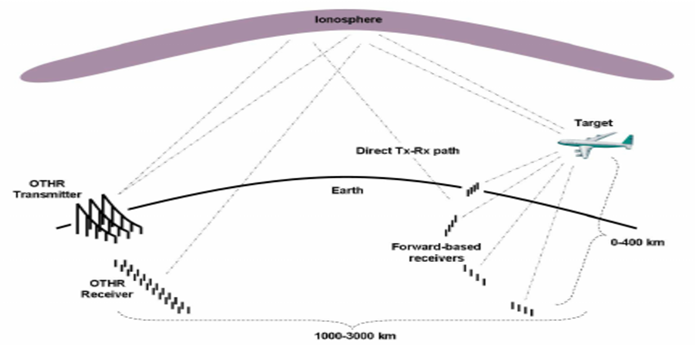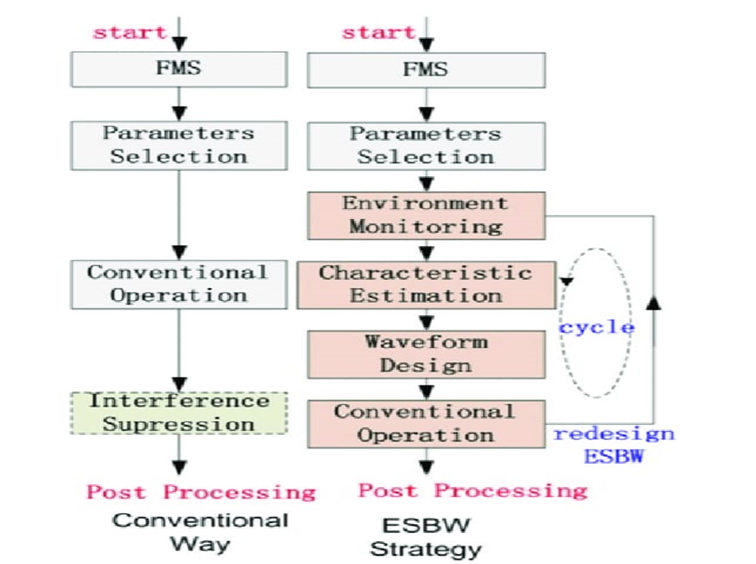Over-the-Horizon Radar (OTH), sometimes called Beyond the Horizon (BTH), is a radar system with the ability to detect targets at very long distances, from hundreds to thousands of kilometers, beyond the radar horizon, which is the distance limit of ordinary radars. Several OTH radar systems have been deployed since the 1950s and 1960s as part of early warning systems, but these have generally been replaced by airborne early warning systems.
Radars beating over the horizon operate in the high frequency range from 5 to 30 MHz in which the external electromagnetic environment is a space-time variant surrounded by radiofrequency interference and atmospheric, cosmic and man-made noise. These radars are suitable for detecting targets at very long distances and use powerful radio signals that are transmitted using a very large antenna or a series of antennas. Signals are reflected from the ionosphere to reach the target. OTH radars are usually used as early warning and threat detection systems. They are also used for navigation and surveillance on commercial and military vessels. To avoid co-channel interference, the frequency management system is required in the OTH radar to provide information about the channel occupancy and noise level to select the operating frequency.
Principle of operation

OTH radars use two main techniques to detect long-range targets:
1. Propagation of shortwaves: in the propagation of shortwaves, radio signals in the frequency range are transmitted at a certain angle from an antenna or series of antennas. These signals are refracted to the ground by the ionosphere, thus allowing them to return to earth beyond the horizon. Upon reaching the target, some of these signals are reflected back into the ionosphere and return to the source in the same path. For an effective reflection process, the angle between the signal and the ionosphere, which is generally about 2-4° outside the local horizon, should be precise. The transmission of a beam at this angle requires enormous networks of antennae and a strongly reflective terrain along the path through which the signal is sent. Real-time monitoring of atmospheric conditions, amplifiers with extremely low noise, and computers are used to efficiently and accurately locate and measure the target's speed.
2. Propagation of surface waves: in this technique, low-frequency radio signals are transmitted and end up being diffracted due to obstacles and follow the curved contour of the earth, reaching beyond the horizon. A reverse dispersion of the signals reflected by the target returns to the transmitter using the same path. In this mode of propagation, radio signals have the greatest range over the sea.

Block diagram
Conventionally: the frequency management system monitors the surrounding ionosphere and background and selects the parameters of the waveform, including wavelength, pulse length and repetition period. Then the transmitter generates an established waveform, for example, a continuous waveformed form, modulated in linear frequency, widely used, which it modulates at the operating frequency and emits high-frequency electromagnetic waves. Each antenna of the receiving matrix is configured to a digital receiver whose received data is sent to the high-speed signal processor, including the digital beam formation.
BSEW strategy (the waveform is based on environmental detection): the radar scheme retains the conventional structure with two exceptions. First, after the frequency management system selects the waveform parameters, the BSBW strategy monitors the medium in real time by the receiving matrix, and the models transmit the adaptive waveform based onthe detection result, instead of generating an established waveform. Secondly, there is no need to cancel the interference in signal processing. Depending on the change in the environment, the ESBW strategy operates in a loop consisting of monitoring the environment, estimating the characteristics of the waveform and conventional operation. Environmental monitoring gathers environmental data for feature analysis. The characteristic estimate analyzes the environmental data and provides information for the design of the waveform. The BSBW strategy tends to suppress environmental interference by the transmission waveform. In conventional operation, OTH radar illuminates the area of interest by ESBW and uses conventional signal processing structure to detect targets.
Types of OTH radars
Veyer: the first experimental model of the Soviet Union, being built in 1949.
Duga: built on the Black Sea coast near Odessa. Facing east, the Duga first ran in November 1971 and was successfully used to track missile launches in the Far East and Pacific Ocean. This was followed by the Duga-1 radar which operated from July 1976 to December 1989. Random, repetitive frequency jumps at a frequency of 10 Hz caused the radar to be known as the "Russian woodpecker." These jumps have often disrupted legitimate broadcasts, ocean-wide commercial aviation communications, and utility transmissions, leading to thousands of complaints from many countries around the world. The signal became so disturbing that some communication receivers began to include it in the design of their circuits.
Sunflower: designed to detect surface and air targets at a distance of 450 km. Allows operators to automatically detect, track and classify up to 300 objects across borders, as well as 100 aerial objects beyond the radio horizon. Currently, 3 stations are on duty in the Sea of Okhotsk, the Sea of Japan and the Caspian Sea.
Cobra Mist: the OTH radar in the UK/USA used a 10 MW transmitter and was able to detect the planes over the west of the Soviet Union from its location in Suffolk. When testing of the system began in 1972 an unexpected source of noise made it largely unusable.
Jindalee: Australia's OTH radar was put into operation in 2000. It is a multistical radar, that is, with a separate transmitter and several receivers located in different places, allowing to obtain a long range.
Nostradamus: it was built in France and entered service in favor of the French army in 2005. It is a monostatic radar in which the emission and reception is carried out in the same place, capable of detecting planes at a distance of between 500 and 3000 km. The frequency band used ranges from 6 to 30 MHz. It is able to track American B-2 bombers during raids on Kosovo, detect the launch of an Ariane missile in Guyana and track an aircraft throughout its journey between southern France and arrival in Tunisia with an accuracy of 5 km.
IACIT's 0100-over-horizon radar is the first operational radar, developed and installed in South America. It has the ability to monitor ships at a distance of up to 200 NM, surpassing the direct line of view of conventional radars. Its transmission system uses a Doppler boost. Using the concept of reflective radar provides a simultaneous coverage of 120º in azimuth. The OTH 0100 radar has the transmitting and receiving systems in the same installation area. The reception uses a series of vertical antennas of circular shape, providing simultaneous coverage of the entire sector through several azimuthal beams, digitally formed by a signal processor. The network of circular antennas ensures the correct detection of the target while eliminating the interference effects of ionospheric signals in the system. This radar has a digital processing architecture that allows to suppress various interferences that occur in the HF frequency band, such as human-caused noise and communication interference, providing better detection and tracking of targets.
Romania's first HFSWR ( High Frequency Surface Wave Radar) radar was mounted on Corbu beach, on the Black Sea shore. This radar is described by the manufacturer as an inexpensive and easy-to-carry solution for detecting sea-going vessels up to a distance of 200 NM and aircraft in flight at low altitude. HFSWR radar uses high-frequency electromagnetic signals vertically polarized and reflected by the ionosphere.